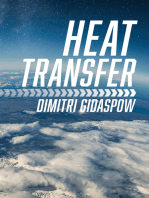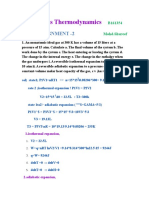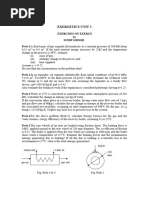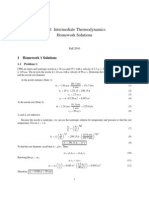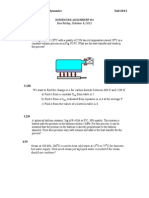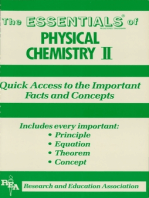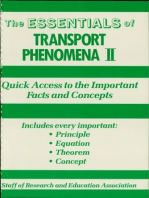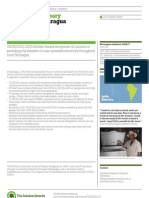Class Note 5
Uploaded by
alihasan12Class Note 5
Uploaded by
alihasan12August 29, 2001 Reading: Chapter Two Homework: 2.1,2.3,2.5,2.
Numerical Examples: Example 1 (problem 2.2, page 35): One mole of a monatomic ideal gas, in the initial state T = 273 K, P = 1 atm, is subjected to the flowing three processes, each of which is conducted reversibly: a. A doubling of its volume at constant pressure b. Then a doubling of its pressure at constant volume c. Then a return to the initial sate along the path P = 6.643X10-4V2 + 0.6667 Calculate the heat and work effects that occur during each of the three processes. Solutions: Initial state of the gas: P1 = 1atm, T1 = 273 K, V1 = RT1/P1 = 0.08206x273/1 liters = 22.4 liters a. At the state a: Pa = 1atm, Va=2V1 = 44.8 liters, Ta = PaVa/R = 44.8/0.08206 K = 546 K qa = Cp (Ta - T1) = 2.5x8.3144x(546 273) = 5.67 Kilojoules wa = PdV = P(Va V1 ) = 22.4 x 101.3 joules = 2.27 kilojoules
V1 Va
b. At the state b: Pb = 2Pa = 2 atm, Vb = Va = 44.8 liters Tb = PbVb/R = 44.8x2/0.08206 K = 1092 K qb = Cv(Tb-Ta) = 1.5x8.3144x(1092-546) = 6.81 Kilojoules wb = 0 c. At the state c: Pc = P1 = 1 atm, Vc = V1 = 22.4 liters, Tc = T1 = 273 K
wc = PdV = (6.643 10 4 V 2 + 0.6667)dV
Vb Vb
Vc
Vc
1 3 wc = 6.643 10 4 (Vc Vb3 ) + 0.6667(Vc Vb ) 3 1 wc = 6.643 10 4 (22.4 3 44.8 3 ) + 0.6667(22.4 44.8) = 17.42 14.93 3
= -32.35 X 101.3 joules = -3.28 kilojoules U(1 to c) = 0: Ua + Ub + Uc = 0 (qa - wa) + (qb - wb) + (qc - wc) = 0 (5.67 - 2.27) + (6.81-0) + (qc (-3.28)) = 0 qc = -13.49 kjoules Example 2 (page 29): Ten liters of a monatomic ideal gas at 25oC and 10 atm are expanded to a final pressure of 1 atm. Calculate the work done, the heat absorbed, and the change in U and H for the gas if the process is carried out (1) isothermally and Reversibly, and (2) adiabatically and reversibly. Having determined the final state of the gas after the reversible adiabatic expansion, verify that the change in U for the process is independent of the path taken between the initial and final states by considering the following alternative processes: i. ii. iii. iv. v. An isothermal process followed by an isometric process An isometric process followed by an isothermal process An isothermal process followed by an isobaric process An isometric process followed by an isobaric process An isobaric process followed by an isometric process
Solution: textbook, page 30-34.
You might also like
- Harry B. Joseph - Book of Wisdom. 1-Revival of Wisdom91% (67)Harry B. Joseph - Book of Wisdom. 1-Revival of Wisdom123 pages
- COSMIC CONSCIOUSNESS OF HUMANITY - PROBLEMS OF NEW COSMOGONY (V.P.Kaznacheev,. Л. V. Trofimov.)94% (212)COSMIC CONSCIOUSNESS OF HUMANITY - PROBLEMS OF NEW COSMOGONY (V.P.Kaznacheev,. Л. V. Trofimov.)212 pages
- Quantum Magick Reconfiguring The Field, A Powerful Companion To Mind Magic Methods (The Mind Magic System Book 2) (Merlin Starlight) (Z-Library)92% (12)Quantum Magick Reconfiguring The Field, A Powerful Companion To Mind Magic Methods (The Mind Magic System Book 2) (Merlin Starlight) (Z-Library)225 pages
- Student Exploration: Fan Cart Physics (Answer Key)46% (24)Student Exploration: Fan Cart Physics (Answer Key)4 pages
- The Road From Orion (The Isis Thesis Book 1)100% (19)The Road From Orion (The Isis Thesis Book 1)178 pages
- Astrological Transits - The Beginner's Guide To Using Planetary Cycles To Plan and Predict Your Day, Week, Year (Or Destiny)90% (31)Astrological Transits - The Beginner's Guide To Using Planetary Cycles To Plan and Predict Your Day, Week, Year (Or Destiny)317 pages
- (1.0) Kenneth William Ford - The Quantum World - Quantum Physics For Everyone100% (1)(1.0) Kenneth William Ford - The Quantum World - Quantum Physics For Everyone311 pages
- Journey To The Year 3000 - Choose Your Own Super Adventure100% (2)Journey To The Year 3000 - Choose Your Own Super Adventure90 pages
- Project: Green Building Technologies and Energy Conservation50% (2)Project: Green Building Technologies and Energy Conservation50 pages
- Chapter 03 The First Law of Thermodynamics (PP 59-81)100% (1)Chapter 03 The First Law of Thermodynamics (PP 59-81)23 pages
- Exercícios Resolvidos - Cap. 02 (B) - AtkinsNo ratings yetExercícios Resolvidos - Cap. 02 (B) - Atkins26 pages
- ENGR 2213 Thermodynamics: F. C. Lai School of Aerospace and Mechanical Engineering University of OklahomaNo ratings yetENGR 2213 Thermodynamics: F. C. Lai School of Aerospace and Mechanical Engineering University of Oklahoma20 pages
- Ho Chi Minh University of Technology: Experimental ReportNo ratings yetHo Chi Minh University of Technology: Experimental Report13 pages
- CHEM 111 Physical Chemistry I Problem Set 2 - 1 Law of ThermodynamicsNo ratings yetCHEM 111 Physical Chemistry I Problem Set 2 - 1 Law of Thermodynamics1 page
- Sharing Is Caring Assignment: Thermal ProcessNo ratings yetSharing Is Caring Assignment: Thermal Process6 pages
- School of Chemical Engineering: Chem 251 Assignment 1 and 2No ratings yetSchool of Chemical Engineering: Chem 251 Assignment 1 and 216 pages
- Computer (Electric Load) Pressure Regulator H Feed Line E E: Anode Anode Electrolyte Electrolytecathode CathodeNo ratings yetComputer (Electric Load) Pressure Regulator H Feed Line E E: Anode Anode Electrolyte Electrolytecathode Cathode6 pages
- Chapter1R+2 Assignment Questions 2023 VFNo ratings yetChapter1R+2 Assignment Questions 2023 VF2 pages
- Multiple Choice Questions On Mechanics and HeatNo ratings yetMultiple Choice Questions On Mechanics and Heat21 pages
- Chapter 6 Thermodynamics: The First Law: Systems, States, and Energy (Sections 6.1-6.8)100% (2)Chapter 6 Thermodynamics: The First Law: Systems, States, and Energy (Sections 6.1-6.8)12 pages
- Chapter 5 - Section A - Mathcad Solutions: 5.2 Let The Symbols Q and Work Represent Rates in Kj/s. Then by Eq. (5.8)No ratings yetChapter 5 - Section A - Mathcad Solutions: 5.2 Let The Symbols Q and Work Represent Rates in Kj/s. Then by Eq. (5.8)21 pages
- Analytical Modeling of Solute Transport in Groundwater: Using Models to Understand the Effect of Natural Processes on Contaminant Fate and TransportFrom EverandAnalytical Modeling of Solute Transport in Groundwater: Using Models to Understand the Effect of Natural Processes on Contaminant Fate and TransportNo ratings yet
- Book of Wisdom Part 1 Revival of Wisdom (22 28)100% (10)Book of Wisdom Part 1 Revival of Wisdom (22 28)7 pages
- A Short History of Nearly Everything - SuperSummary Study Guide100% (1)A Short History of Nearly Everything - SuperSummary Study Guide57 pages
- Andromeda: The Chained Woman: Joshua Wihongi Physics 1040 Sp17 Constellation PaperNo ratings yetAndromeda: The Chained Woman: Joshua Wihongi Physics 1040 Sp17 Constellation Paper11 pages
- Environmental Law: Tutorial Topic-Regulation of Hazardous Industries - Legal and Institutional FrameworkNo ratings yetEnvironmental Law: Tutorial Topic-Regulation of Hazardous Industries - Legal and Institutional Framework11 pages
- Activity2 3 2greenbuildingandsustainabledesignNo ratings yetActivity2 3 2greenbuildingandsustainabledesign2 pages
- Dokumen - Pub Stars and Stellar Processes 9781107197886No ratings yetDokumen - Pub Stars and Stellar Processes 9781107197886813 pages
- Chapter 5: Plate Tectonics: Teaching Support For Pages 180-181 Syllabus LinksNo ratings yetChapter 5: Plate Tectonics: Teaching Support For Pages 180-181 Syllabus Links58 pages
- STS 21. Plasma Technology in Food and Agriculture IndustryNo ratings yetSTS 21. Plasma Technology in Food and Agriculture Industry44 pages
- Government College of Engineering, Amravati: Dr. S. M. LawankarNo ratings yetGovernment College of Engineering, Amravati: Dr. S. M. Lawankar31 pages
- First Quarter Exam in Science 8 S.Y. 2019-2020: Item NumberNo ratings yetFirst Quarter Exam in Science 8 S.Y. 2019-2020: Item Number6 pages
- Ii-27 Ingles Ii Unidad 1 Univalle 2019BNo ratings yetIi-27 Ingles Ii Unidad 1 Univalle 2019B36 pages
- 1 - Introduction - Sediemntology 2018 PDFNo ratings yet1 - Introduction - Sediemntology 2018 PDF20 pages





















